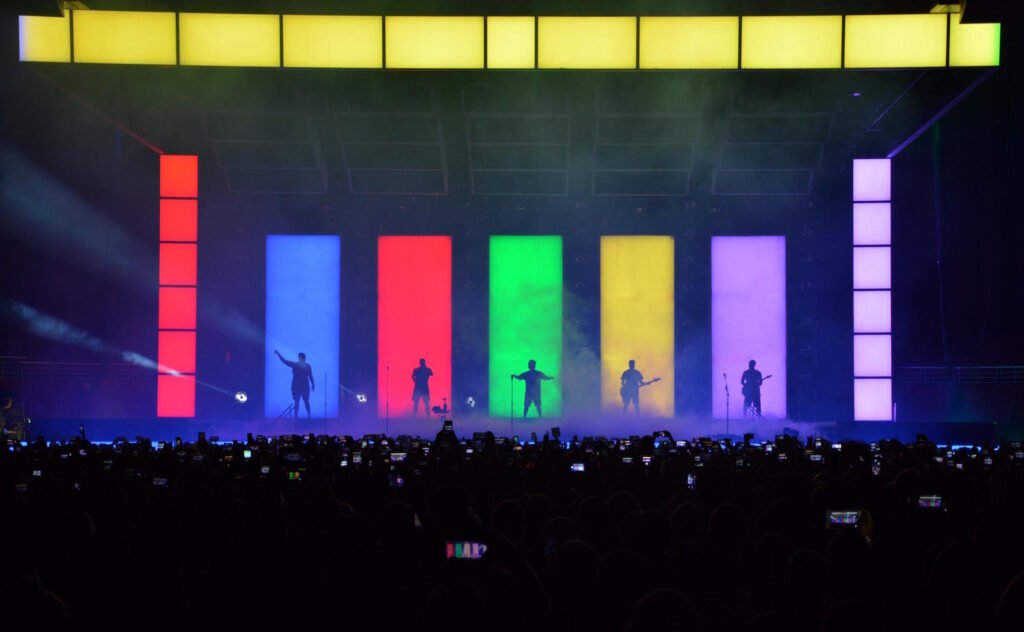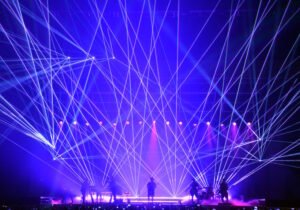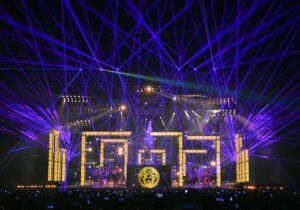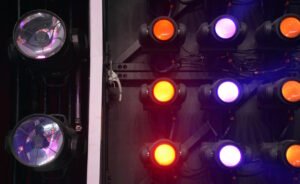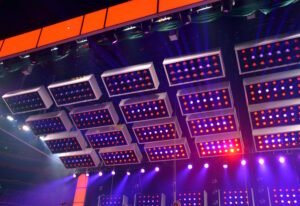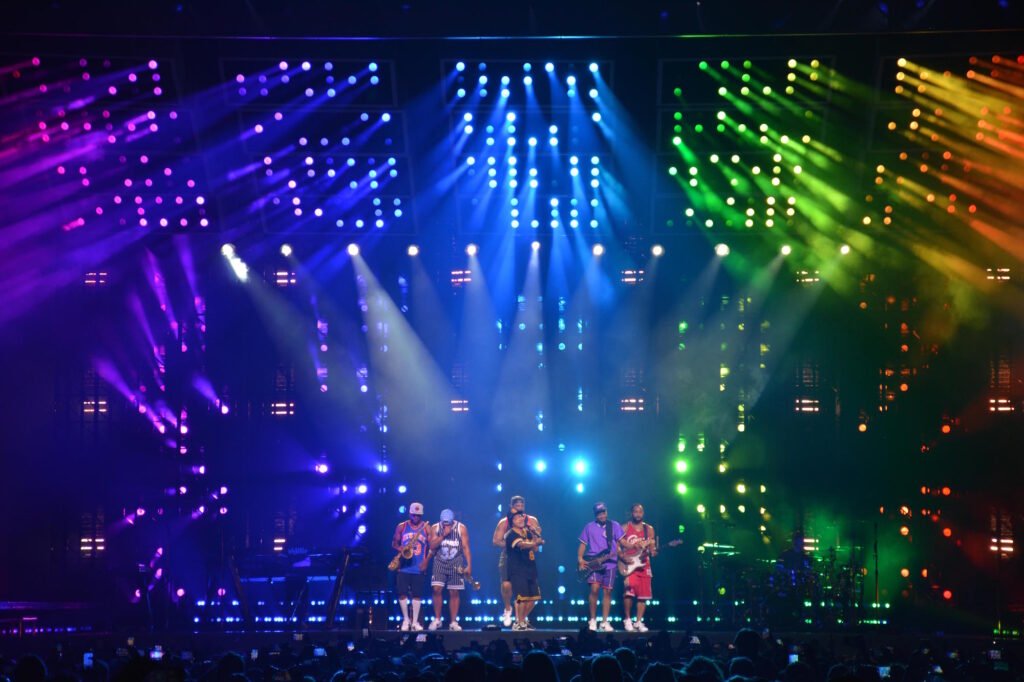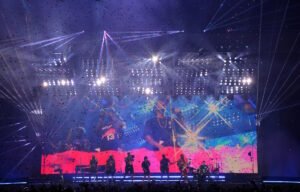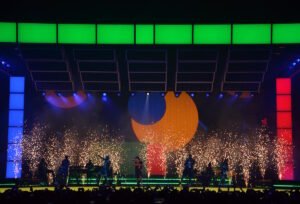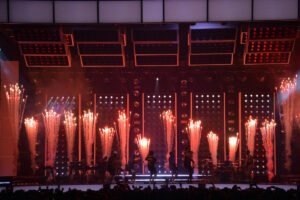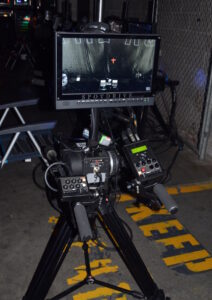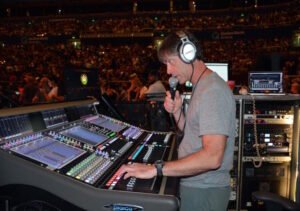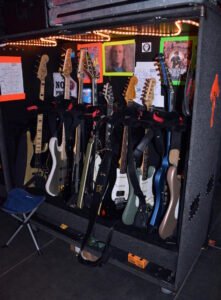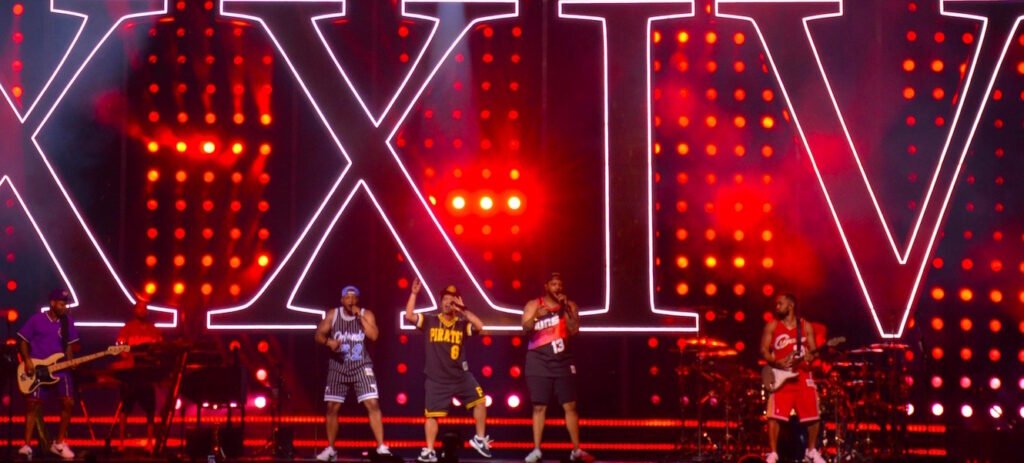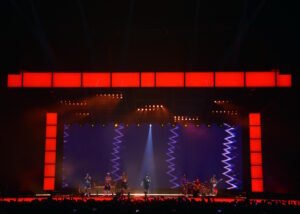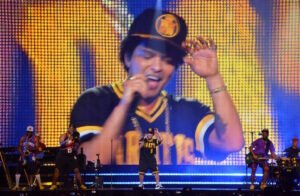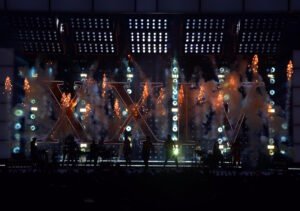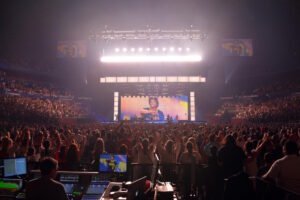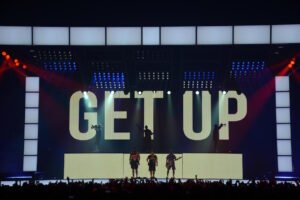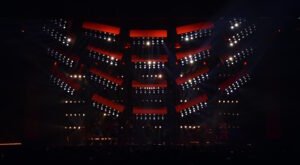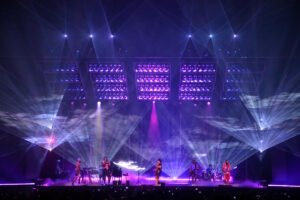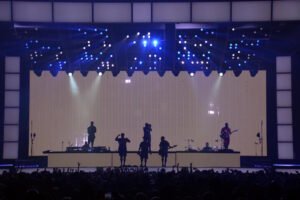News
15 May 2018
Bruno Mars

Subscribe to CX E-News
ROADSKILLS
Bruno Mars
By Cat Strom
Bruno Mars is the consummate entertainer; a singer-songwriter, record producer, multi-instrumentalist, pretty good dancer, and all round nice guy too. His 24K Magic World Tour, which sold out numerous arena dates in Australia, was a nod to classic shows by artists like the Jacksons and Queen, with Production Designer LeRoy Bennett and Lighting Designer and Programmer Cory FitzGerald echoing that era of vintage rock and R&B looks with a modern interpretation.
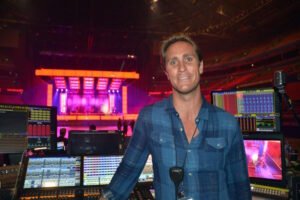
Whitney Hoversten (LX Director & Programmer)
Lighting Director and Programmer Whitney Hoversten has been on the road with the tour since it started in March 2017. The Sydney show I attended was the 131st. Not that he is counting.“I think we have around fifty more shows this year,” he said. “That’s just the tour show, periodically we also do a residency show at the Monte Carlo in Las Vegas which has a completely different design.”
Prior to the show opener, the main stage is masked by an Austrian curtain adorned with an intricate image of a golden crown. When the show begins, the curtain rises revealing Bruno Mars and his band on a bright, neon-lit stage reminiscent of a funky, fresh stage set design from the 80’s and 90’s.
The first song Finesse sets the tone from a visual stand point of what Bruno wants to accomplish with this tour. It is dominated by big blocks of primary colours, which were Bruno’s idea, and Whitney admits the creative team cringed when they first heard about it. “It’s about a time period and it does set the tone for the rest of the show,” said Whitney. “It’s now one of my favourite looking songs in the show.”
By the time they get to the third song Treasure, the video wall makes an appearance via automated motors, and at close to 7 metres in height and the width of the stage, it’s a large presence. Lasers make a massive appearance in the ballad Calling All My Lovelies and in Versace the ‘tetris blocks’ come into play; plexiglass lightboxes internally lit by LEDs that drastically change the environment.
The Tait Towers custom built stage features a lit up stage floor and eight elevating lifts that individually and collectively showcase Bruno, his band, and the performers at different heights. The creative team considered the audience sightlines from every seat in the arena and used the lifts to enhance those sightlines. The lifts are first used in Versace, as are more lasers.
“A lot of things in the show are very block-inspired to emulate the early 80’s Par can rig but of course with modern technology, and that’s where the Spikies come into play,” said Whitney. “It’s reminiscent of a Queen show with big banks of Par cans and the Spikies have been great at doing that.
The show utilises a whopping 795 Robe Spikies, with 375 Spikies built into five upstage columns, the other 420 contained in 20 moving over-stage pods, all constructed by Tait together with the automation systems to move them. The five back columns are each loaded with a 5 wide and 15 fixtures high matrix of Spikies, and the reverse side of the column is covered in an RBG LED ‘lightbox’ paneling material for contrast. They rotate to reveal the different sides throughout the show.
The 20 pods over the stage are rigged in a five-wide-four-deep configuration, each loaded with a 7 x 3 Spikie format utilizing 21 fixtures per pod, and these move into a series of different looks throughout the set. “The pods travel fully contained, except for the white fascias which magnet onto the front, we just pop wheels onto them and they roll away; it’s a really fast process,” added Whitney.
“The Spikies were a brand new fixture hot off the assembly line when we started this tour so it was a bit of a risk using them but we’ve had hardly any problems. The few we did have, Robe was straight onto it. In fact I would say the Spikie is one of the most reliable fixtures I have worked with.”
The pods first move several songs into the set during Marry You and this adds a whole new dimension to the stage and lighting. This is followed by Runaway which Whitney says is always a fun song to run as it is cued very heavily.
Forty-eight Philips Vari-Lite VL6000 Beams are rigged on vertical truss facing out, while 53 Philips Vari-Lite VL4000 BeamWash fixtures provide backlight, sidelight and a myriad of bright, bold effects.
“The VL4000 BeamWash fixtures are scattered throughout the rig and are used to light everyone onstage as well as act as an effect light,” added Whitney. “They stretch the entire perimeter of the stage and are also on the downstage truss. The VL6000 is our big punchy beam, kind of like a modern day Syncrolite, which we use for big looks and they cut through everything. A total of 214 TMB Solaris Flares are key components of the lighting rig with 70 on the downstage truss alone.”
These are mounted vertically, end-to-end, as a single ‘bar’ downstage for main audience effect lighting. A further 68 are mounted in the stage facing up, to under-light the transparent floor “cells” and 76 hung throughout the rig and upstage from trusses, for stage strobing and more effects.
“I’ve really enjoyed using the Solaris Flares particularly on the downstage truss where they are butted up against each other so there’s really no break in the pixels,” commented Whitney. “It’s a lot of them in one place and LeRoy is probably the only designer who can get away with it!”
Pyrotechnics are a big part of this show with Pyroteck Special Effects Inc delivering a total of ten pyro zones: eight zones positioned across the mid-stage area along with two in the truss. To keep the stage as clean as possible, the pyros are flush mounted, literally embedded in the stage and loaded from the bottom. They also supplied the lasers.
Above the rig is a gigantic black drape to conceal all the show’s ‘gags’ as they wait their turn in the spotlight.Control was an MA2 with Cory and Whitney spending days programming the show prior to the tour. Despite being a year into the tour, Whitney is still changing and molding the design.
“I was in Bruno’s dressing room half an hour before you got here talking about something I’ve changed,” he added. “We bounce ideas off each other and with Bruno, it’s never a complete canvas. But that’s why he is one of my favourite artists to work with and I love that we are still changing things after 130 shows! In New Zealand we spent five hours tweaking one song together.”
The majority of the show is time-coded which leaves Whitney able to focus on calling the eight ground-controlled spots. In Australia and anywhere other than the US, they were using SPOTDRIVE by [LITE]COM handlebar-based moving head luminaire controller which Whitney says is a great system, particularly as it can be attached to any moving light.
FOH engineer Bill Sheppell had only been with the tour a short time taking the place of Chris Rabold, who had to bow out of the tour. Bill was keen to work with a new artist as his other clients, mainly Bon Jovi and John Mellencamp, whilst great, do not work as much as Bruno!
“It’s been a good gig work-wise for me,” he said. “Chris made it really easy because it was a planned changing of the guard. He worked with me as far as giving me his session files so I could see what was going on. “Fortunately we both work on the DiGiCo platform so I could work from that, making it my own. Every engineer has his own way of doing things, but it was an easy transition between the two of us.”
Bill took over in Mexico after watching Chris mix the show just once, however Chris stayed on for a couple of shows to ensure Bill was pushing the right buttons! Bill changed the session to suit his way of mixing, as well as some of the outboard gear.“Basically it is now a heavily modified version of Chris’ file but it was nice to be able to come in with all the input gains in the right spot,” said Bill.
The Clair Global PA system per side consisted of sixteen CO12 boxes on the main hang, fourteen CO12 on the side hang and twelve CO8 on the upstage hang. Added to that were six CP218 flown subs and two more on the ground each side to fill in the centre.
Four CP6 front fill boxes are built into the front fascia of the stage, along with four CP218 sub front fills in cardioid. The main system was driven by rack-mounted Lab.gruppen PLM 20K44 4-channel amplifiers, all of which incorporate Lake digital processing. Bill runs the show on a DiGiCo SD7, just like Chris did, and says that coming into a tour midway there’s no time to change the horse you’re on! “It’s my favourite platform at this time and the console I feel most comfortable using,” he remarked.
“I’m using a Waves bundle of H-reverbs, delays, pitch wideners … but not a ton of effectson this show. There are two different delays on Bruno, a short and a long, and I use a doubler on his vocal to widen it, along with an AMS reverb from a UAD Apollo.
Background vocals have an H-reverb and a delay for certain effects and cues.” Bill remarked that a Bruno show is very dynamic and certainly keeps him on his toes! “The band is down a singer at the moment who did a lot of parts, so two of the horn players are covering those parts and they’ve settled in really well. I had to chase them around a bit but that’s all settled down.”
Bruno’s microphone was a DPA d:facto with Shure Axient wireless system and Bill notes that his biggest challenge is that Bruno doesn’t put his mic very close to his mouth. “So I have to get his mic to where it sits well without picking up a ton of audience and stage bleed,” he added.
“He’s got a great voice and is super talented, but it’s just the way he does it; he’s making me work for it! The DPA d:facto is my favourite mic especially if you’re going to have bleed in a mic, as it sounds natural. You can also cup the mic and it doesn’t get too unstable, and it doesn’t get super pointy.”
The rest of the mics included Shure Beta 91A on kick 1, Telefunken M82on kick 2, Shure SM57 on snare 1 top, Granelli 5790 snare 2 top, Telefunken M80SH on snare 1 and 2 bottom, Mojave MA-101FET on Hi-Hat and ride, Shure Beta 98MP on toms and floor toms, Telefunken M82 on large tom, Mojave MA-201 on overheads and Radial JDI on SPD and kick trig.
Monitor engineer Ramon Morales also used a DiGiCo S7. There are no wedges or any other loudspeakers for monitoring on stage; everyone is outfitted with JH Audio earpieces fed by Shure PSM 1000 personal monitor systems.
During most shows, there is a noticeable time when more audience members get up to go to the bar or to the bathroom. This doesn’t happen in a Bruno Mars show.
Bruno Mars CX Cameral Roll:
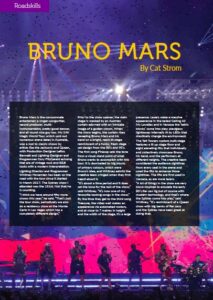
This article first appeared in the print edition of CX Magazine May 2018, pp.42-46. CX Magazine is Australia and New Zealand’s only publication dedicated to entertainment technology news and issues. Read all editions for free or search our archive www.cxnetwork.com.au
All text and photos © CX Media
Subscribe
Published monthly since 1991, our famous AV industry magazine is free for download or pay for print. Subscribers also receive CX News, our free weekly email with the latest industry news and jobs.

